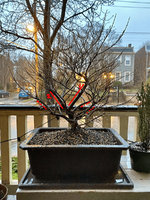@zero Welcome to the site! Sorry I am late to this thread... In the words of Gandalf "I was delayed"

The interesting thing about your cultivar is that in fact, no one really knows what it is. It comes from the Hillier nurseries (in UK), and was named after Jacqueline Hillier, who collected it from a private garden with unknown provenance. No one knows where it came from, and no one knows its species. In the trade, it is listed as
Ulmus X "Jacqueline Hillier" or some version thereof... such as
Ulmus X hollandica "Jacqueline Hillier" (as an unknown hybrid of U. hollandica and an unknown species). Despite its questionable history, it is very popular in landscape, to such an extent that it may ultimately become its own species

As far as your tree is concerned, you have to look at it with the future in mind. Right now it has good bones... if you wanted a bonsai that is 12" tall. However if you want it to grow larger and increase the caliper, you have to decide how you want to guide that growth. If you want a 12" (tall) tree, you would have one plan. If you want a 12" (wide) tree, you would have a very different plan.
Some of it has to do with the tree species... and what would look best for the tree. An American elm that is 12" tall? Perhaps not so good. A Chinese elm - Seiju or other dwarf - as a 12" tall? Easy. Jacqueline Hillier is unique on many levels, but I consider it a smaller elm with smaller leaves on average. So you have to think like a tree artist - and with the the species as your pallet... what can you do to maximize its beauty?
[EDIT] Wait. What? Apologies, but for whatever reason I read this thread the first time, and perhaps (due to skimming) I mistakenly thought we were talking about Hillier elms instead of Dutch elms. They are closely related... but not the same. Sorry about the distraction, but my comments about styling for future growth are still applicable, IMHO [/EDIT]





